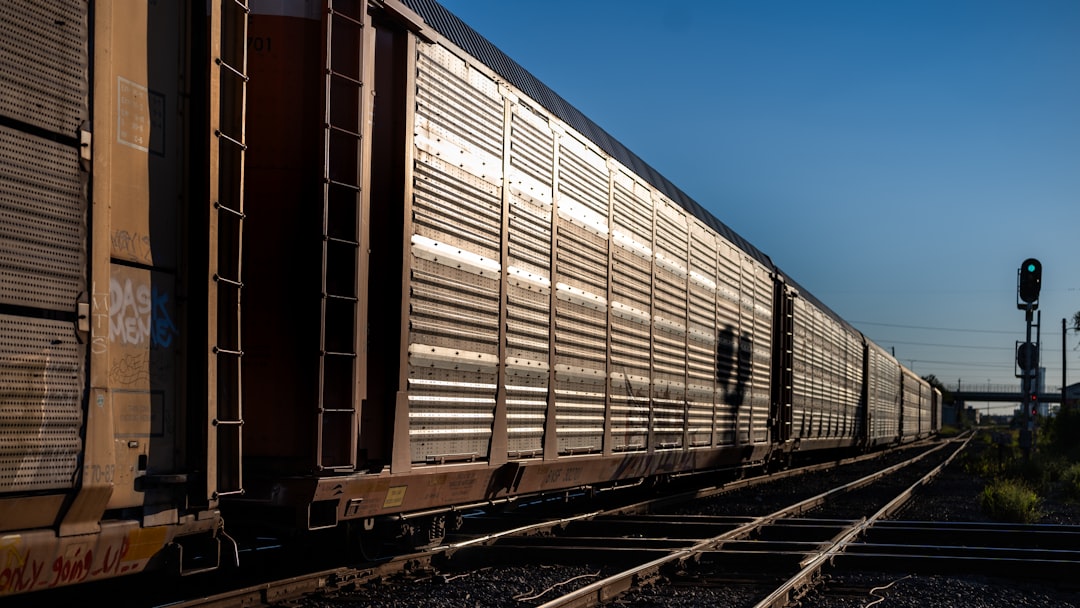

Engage prospects with a scan and streamline customer engagement with FREE QR code marketing tools by Sona – no strings attached!
Create a Free QR CodeFree consultation

No commitment

Engage prospects with a scan and streamline customer engagement with FREE QR code marketing tools by Sona – no strings attached!
Create a Free QR CodeFree consultation

No commitment
QR codes have evolved from a novelty to a strategic powerhouse in bridging offline engagement with online action. For railroad car leasing companies, QR codes represent a frictionless and highly effective way to streamline operations, enhance customer onboarding, and accelerate leasing cycles without any app download or complex setup required.
The railroad car leasing landscape is rapidly evolving. Decision-makers face increasing pressure to optimize asset utilization, improve client communications, and ensure regulatory compliance, all while managing tight margins. Missed opportunities can occur from slow onboarding, incomplete compliance, or failing to capture high-value prospects who engage offline but never enter the CRM. QR codes in marketing offer a scalable solution by connecting physical assets to digital workflows for maintenance tracking, contract access, and surfacing engagement signals where traditional measurement falls short.
This article explores how QR code technology enables instant, actionable access for railroad car leasing companies, supporting better asset management, lead generation, and operational efficiency. Through real-world scenarios, we will highlight common industry challenges and show how strategically deployed QR codes deliver measurable results in marketing, operations, and customer experience.

Many leasing companies struggle with manual workflows, lost paperwork, and missed prospects who never make it into the sales funnel. QR codes bridge the gap between physical touchpoints and digital outcomes, making it easier for railroad car leasing companies to improve asset management, customer engagement, and compliance, while capturing valuable intent data that often slips through the cracks.
A seamless access strategy starts by identifying where friction appears today. Common culprits include paper inspection forms, printed leasing agreements, and static maintenance logs that never get digitized. When these moments rely on manual handoffs, follow-up becomes inconsistent and engagement goes unmeasured. QR codes turn each of these points of friction into a one-scan action that is simple, traceable, and easy to optimize.
Here’s an effective workflow:
Every stage, from creation and deployment to tracking and integration, benefits from a unified workflow that converts once-offline processes into digitized, trackable, and actionable steps. With a platform such as Sona QR, teams can update destinations, track scans by location, and push insights directly to systems like Salesforce or HubSpot, accelerating both operational performance and revenue impact.

Railroad car leasing companies operate in environments where physical assets, printed documentation, and field interactions dominate the customer experience. Traditional processes often silo information, making it difficult to understand which organizations interact with signage, collateral, or assets, and which individuals are ready to move forward. That gap results in missed follow-up with high-value prospects who never submit a form or call a sales rep. QR codes close this loop by converting offline actions into digital signals that teams can act on quickly.
Whether it is a yard sign directing contractors to a safety checklist or a leasing packet inviting a procurement lead to request a quote, QR codes reduce friction, increase compliance, and reveal intent. They also allow operations and marketing teams to align on shared data, so every scan becomes a measurable step in the leasing journey.
In practice, railroad car leasing companies use QR codes on asset tags, inspection sheets, onboarding kits, and direct mail pieces to streamline communications, surface intent, and drive compliance more efficiently than traditional methods. The result is a measurable way to connect physical-world engagement to digital workflows that save time and generate revenue.

Many industry workflows break down because information never makes it from the field into central systems. Choosing the right QR code format ensures that each scan routes people to the action that fits their context, whether they are a field tech, a lessee, or a procurement stakeholder.
Dynamic QR codes are strongly recommended for most operational and marketing use cases. They allow updates to destination content without reprinting and integrate with platforms like Sona QR for attribution, segmentation, and identity resolution. Static codes still work for permanent resources such as a stable PDF or evergreen contact card, but they limit measurement and optimization.
Growth often stalls because signals of client intent, like visiting a rail yard, requesting maintenance, or reviewing a lease packet, never make it into sales or nurture workflows. QR codes transform these touchpoints into measurable events and guided experiences, ensuring each interaction prompts the next step and leaves a data trail.
Map your physical environment and printed assets to likely buyer or user intents. Then place scannable prompts where action is most logical. The result is an ecosystem in which prospects, customers, and staff can do the right thing faster, while your systems record and respond in real time.

Industry practitioners know that missed engagement signals, such as abandoned forms and unsigned documents, translate into lost revenue and audit risk. Carefully designed QR code workflows resolve these points of failure by making the next step easy and measurable.
The most effective deployments align a user’s context with a specific outcome, for example an inspector who needs to open the correct checklist for a particular car class or a procurement manager who wants to request a quote without calling. Below are common use cases mapped to outcomes you can track and optimize.
Digitized workflows do not just improve compliance and speed. They create a direct line between what used to be anonymous asset interactions and the sales intelligence your team needs, ensuring every meaningful action is captured and leveraged.
Traditional lead generation often misses the stakeholders who interact with railcars and documentation offline, such as maintenance managers, site supervisors, or procurement evaluators. Every QR scan is a signal of interest and context. With the right setup, railroad car leasing companies can turn these signals into segmented audiences for targeted outreach, nurture, and revenue expansion.
Segmentation should reflect the lifecycle stage, the user role, and the physical context of the scan. For example, a yard-based scan likely indicates operational intent while a brochure scan at a trade show often signals buying research. Treat these signals differently with tailored content and outreach cadences.
With Sona QR, each code becomes a smart entry point that enriches your data with time, device, and location signals. Sona.com can connect these scans to account profiles and multi-touch journeys, unlocking retargeting based on real behavior rather than assumptions.
Disconnected campaigns produce inconsistent messaging and wasted spend. QR codes serve as the connective tissue between offline railcar touchpoints and your digital stack, ensuring that every scan is captured, attributed, and put to work in real time.
A cohesive strategy builds continuity from first exposure to signed lease. Printed and physical prompts invite action while digital systems personalize content and track progression. This integrated approach is especially valuable in long sales cycles where multiple stakeholders evaluate options across weeks or months.
Centralized campaign management and analytics through platforms like Sona QR ensure that each touchpoint informs the next, reducing friction and enabling consistent, data-driven messaging. The result is a connected experience that moves people from awareness to decision with fewer delays.
Building an effective QR program requires a simple plan that aligns goals, formats, design, deployment, and measurement. The following checklist reflects high-impact steps for railroad car leasing companies and can be repeated for each use case, from inspections to digital leases.
Start by selecting the specific process you want to improve. Focus on moments where intent signals are easily missed or lost, such as inspections that rely on paper, proposals that sit in an inbox, or yard trainings that lack proof of completion. Define the outcome you want, for example faster inspection submissions, reduced lease signature delays, or higher training compliance.
Choose the QR format based on content and tracking needs. Static codes are fine for permanent destinations such as a stable safety PDF. Dynamic codes are best for any scenario that benefits from updates, analytics, or retargeting.
Design with scannability and clarity. Include your logo, brand colors, and a strong visual frame. Add a clear call to action such as Scan for Asset Details, Scan to Start Lease, or Scan for Inspection Log. Test rigorously across devices, distances, and lighting conditions to ensure reliability.
Roll out the codes in the locations and materials that align with the use case. For operations, prioritize railcar plates, maintenance bays, and yard signage. For sales and marketing, focus on brochures, proposals, direct mail, trade show materials, and business cards.
Monitor scan volume, completion rates, and conversion to downstream actions like form submissions, e-signatures, or scheduled service. Use real-time analytics to surface high-engagement accounts and automate follow-up before interest cools.
A unified QR workflow avoids the most common pitfalls and ensures that every deployment delivers measurable operational or commercial impact. Treat each use case as a mini product launch: plan, test, deploy, measure, and iterate. Start creating QR codes for free.
Many railroad leasing companies struggle to connect physical engagement to pipeline and revenue outcomes. Without clear attribution, it is difficult to know which yards, materials, or touchpoints drive progress. Modern QR analytics solve this by collecting granular scan data, linking it to buyer journeys, and surfacing the next best action for sales or operations.
With the right platform, scan data becomes actionable intelligence. It tells you which accounts are engaging, what they engage with, and how that engagement correlates with conversions. Teams can move beyond anecdotal reporting and confidently invest in the placements and messages that work.
With Sona QR and Sona.com, you can push scan events to HubSpot or Salesforce, enrich contacts with behavior data, and use identity resolution to connect anonymous scans to known buyers. Sona’s Buyer Journeys feature unifies QR scans with website visits, ad clicks, emails, and CRM activity so you can see complete progression from first scan to multi-touch attribution.
Sustained success requires capturing every intent signal and closing operational gaps that cause churn or wasted spend. Think beyond a single QR deployment, and treat your codes as a connected network that supports operations, compliance, and commercial outcomes.
Start small with a pilot in one yard or with one car type, measure impact, and roll out across the fleet. Use the insights to refine messaging, destinations, and follow-up workflows, and train teams to reinforce scanning behavior in day-to-day operations.
Creative deployment examples include embedding QR codes on invoices to simplify payment and feedback, adding codes to onboarding packets for digital fleet orientation, and placing codes near brake inspection points to launch the exact checklist required for that class of car.

Leading lessors are turning friction points into growth opportunities by integrating QR codes into their daily workflows. While every fleet and client portfolio is different, the patterns below show how digitization pays off when paired with measurement and iteration.
Operational teams appreciate how QR codes eliminate errors and speed up routine steps. Commercial teams value the new visibility into intent, which helps them prioritize outreach and find expansion opportunities in existing accounts.
These examples demonstrate how QR workflows convert anonymous engagement and manual processes into measurable, repeatable wins. The common denominator is not a single tactic, but the cycle of design, deployment, tracking, and optimization.
Experience shows that QR code success is not only about the code itself, but also the environment, message, and follow-through. When teams plan placements carefully, clarify the action, and connect results to systems, scan rates and outcomes improve.
Missteps tend to cluster around poor placement, vague CTAs, and disconnected analytics. Avoid these pitfalls by testing in real environments and confirming that the destination page makes next steps obvious and fast.
QR codes have shifted from a minor convenience to a core asset for railroad car leasing companies, turning every railcar, document, and client touchpoint into a gateway for digital engagement and actionable insight. By capturing signals that would otherwise remain hidden, leasing providers can deliver seamless client experiences and improve compliance, pipeline visibility, and operational efficiency.
Equipped with scalable solutions and real-time data intelligence, railroad car leasing companies are uniquely positioned to track engagement, drive high-value lead generation, and prevent lost opportunities, closing the loop between physical asset management and digital business growth. As the industry continues to evolve, those who turn offline interactions into measurable value will set the pace for future success.
QR codes have transformed the railroad car leasing industry from traditional, paper-heavy processes into seamless, tech-enabled access points. Whether it’s streamlining asset management, enhancing customer access to leasing information, or enabling instant updates on car availability, QR codes replace cumbersome manual steps with fast, mobile-friendly interactions that capture valuable engagement data. Imagine instantly knowing which railcars are in demand and providing clients with real-time access to leasing details—all from a simple scan.
With Sona QR, you can create dynamic, trackable QR codes tailored to your fleet, update leasing information on the fly without reprinting, and connect every scan to actionable business insights. No missed opportunities, no delays—just smarter, more efficient asset management that drives customer satisfaction and retention. Start for free with Sona QR today and turn every scan into streamlined access, deeper engagement, and faster leasing decisions.
QR codes provide frictionless access to digital workflows, improve asset management, enhance customer engagement, increase compliance, and capture valuable intent data that bridges offline and online interactions.
They can digitize analog processes like inspection forms and leasing agreements, deploy QR codes on railcars for maintenance and safety access, centralize analytics for engagement tracking, and integrate scan data with CRM systems to optimize workflows.
Common formats include web links for fleet data, vCards for contact sharing, forms for inspections and requests, PDFs for technical documents, SMS or email for quick communication, Wi-Fi access codes, and app download links.
Dynamic QR codes allow content updates without reprinting, support tracking and analytics, enable retargeting, and adapt to regulatory or operational changes, making them more flexible than static codes.
Effective placements include railcar plates and tags, maintenance bays, yard and depot signage, leasing office materials like brochures and proposals, direct mail, trade show displays, and business cards.
QR codes enable instant digital access to lease agreements, inspection logs, and support resources, reduce manual paperwork, eliminate follow-up delays, and allow self-service, which accelerates approvals and lease signings.
Key metrics include scan volume, scan-to-inquiry conversion rates, form completion rates, time to lease signature, maintenance completion timing, and revenue or cost savings attributed to QR campaigns.
By linking scan data to CRM records, companies can identify engaged accounts, segment audiences by role and context, trigger automated follow-ups, and create targeted retargeting campaigns based on real user behavior.
Design codes with clear calls to action, ensure high visibility and durable placement, test scannability across devices and environments, use unique codes per asset or document, and maintain a centralized registry for management.
By accelerating lease signings, improving maintenance compliance, and enhancing lead tracking, QR codes reduce operational delays and lost opportunities, which leads to faster revenue recognition and more efficient cash flow.
Avoid poor placement that hinders scanning, vague or generic calls to action, disconnected analytics, static codes for frequently changing content, and lack of staff training on encouraging scans and following up.
QR codes link to up-to-date training modules, safety bulletins, and certification quizzes accessible on yard signs or onboarding kits, improving training completion rates and audit readiness.
The process involves selecting a use case, choosing the appropriate QR code type, designing and testing the code, deploying it across relevant channels, and continuously tracking performance to optimize engagement and outcomes.
They convert physical interactions with railcars, signage, and printed materials into digital data points that can be tracked, analyzed, and connected to sales and operational systems, preventing missed leads and improving follow-up.
The latest trends include integrating dynamic QR codes with CRM and marketing platforms for multi-touch attribution, using scan data for real-time operational decisions, and leveraging QR codes to bridge offline and online customer journeys.
Use Sona QR's trackable codes to improve customer acquisition and engagement today.
Create Your FREE Trackable QR Code in SecondsJoin results-focused teams combining Sona Platform automation with advanced Google Ads strategies to scale lead generation

Connect your existing CRM

Free Account Enrichment

No setup fees
No commitment required

Free consultation

Get a custom Google Ads roadmap for your business






Launch campaigns that generate qualified leads in 30 days or less.
